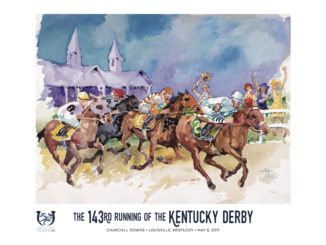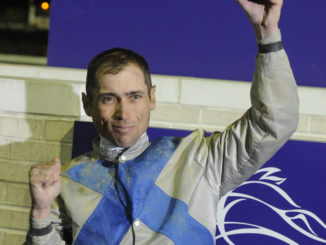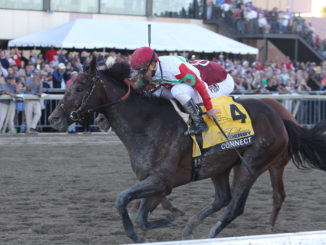
The first Breeders’ Cup held at Churchill Downs, in 1988, memorably produced era-defining performances from the likes of Alysheba, Personal Ensign and Miesque. The first winner on that unforgettably cold, dark and wet afternoon will also be remembered, but for his toughness and amazing longevity.
Gulch was one of the stars of his generation from the get-go. The leading East Coast-based juvenile in 1986 following victories in the Hopeful (G1) and Futurity (G1), the Peter Brant-owned colt shipped early to Santa Anita to prepare for the Breeders’ Cup Juvenile (G1). In the track-and-distance Norfolk (G1), Gulch finished second to the stakes-debuting Capote as an odds-on favorite, but in the Juvenile itself, Gulch could finish no better than fifth to the same rival.
Trainer LeRoy Jolley had Gulch prep for the 1987 Kentucky Derby (G1) three times at Aqueduct. He won twice, including the Wood Memorial (G1) in which Capote finished a distant fourth. It was the longest race the son of Mr. Prospector would ever win, though he would later valiantly place in the Whitney H. (G1), Woodward (G1), Oaklawn H. (G1), Californian (G1) and Philip H. Iselin H. (G1) over the same distance.
Gulch contested the first two legs of the Triple Crown, finishing sixth in the Kentucky Derby and fourth in the Preakness (G1). Shortened up to a mile for the historic Metropolitan H. (G1) nine days after the Preakness and toting a feathery 110 pounds, Gulch edged King’s Swan and 128-pound highweight Broad Brush in adding his name to an exclusive list of three-year-old winners of the famed Met Mile.
It would prove to be Gulch’s final victory of the season. Wheeled back 12 days later in the 1 1/2-mile Belmont Stakes (G1), Gulch did well to finish third to runaway winner Bet Twice. He was only a nose behind runner-up Cryptoclearance and a neck in front of Triple Crown-seeking Alysheba. Gulch was beaten less than a length three other times that season, most notably to fellow three-year-olds Java Gold in the Whitney and Polish Navy in the Woodward. He was less successful going 1 1/4 miles, placing fourth in the Travers (G1) and Marlboro Cup (G1) and ninth in the Breeders’ Cup Classic (G1) at Hollywood Park.
The 1988 season saw Gulch transferred to D. Wayne Lukas, then the hottest trainer in the country. While he would continue to pursue the occasional two-turn race, much of the campaign was focused on winning races around one turn and up to a mile.
The results were more than satisfactory. In the Potrero Grande Handicap at Santa Anita over 6 1/2 furlongs, Gulch turned back the previous year’s Breeders’ Cup Sprint (G1)-winning filly Very Subtle by 1 1/4 lengths. In New York that spring, Gulch defeated 1987 Canadian Horse of the Year Afleet in both the seven-furlong Carter H. (G1) at Aqueduct and in the Met Mile. Gulch remains the last back-to-back winner of the Metropolitan, a feat otherwise accomplished only by Mad Hatter, Equipoise, Devil Diver, Stymie and Forego.
After second-place efforts to King’s Swan in the Tom Fool (G2) and the upstart Mining in the Vosburgh H. (G1), Gulch entered the Breeders’ Cup Sprint at Churchill Downs as the 5-1 second choice. Despite breaking from post 10 and conceding more than seven lengths early on, a fast pace over the sloppy going played to his advantage. Splitting rivals inside the final furlong, Gulch emerged to defeat 1988 Canadian Horse of the Year Play the King by three parts of a length. Past Sprint winners Very Subtle and Precisionist, Afleet and Mining were among the vanquished.
Voted the Eclipse Award as champion sprinter, Gulch stood his entire stallion career at Lane’s End Farm. His most notable offspring was dual classic winner and champion Thunder Gulch, who in turn sired the Hall of Fame colt Point Given. Gulch also sired Breeders’ Cup Mile (G1) winner Court Vision.
Gulch spent his final years at the Old Friends Retirement Farm in Kentucky, where he died in January 2016 at the ripe old age of 32 and proving that he could indeed go a distance.



